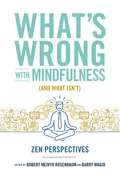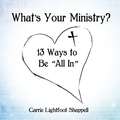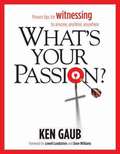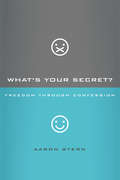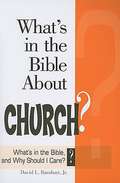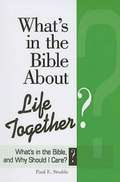- Table View
- List View
What's So Funny About God?: A Theological Look at Humor
by Steve WilkensIf you don't believe God has a sense of humor, just look in the mirror.What’s So Funny About God?
What's So Great About Christianity: Your Guide To Answering The New Atheists
by Dinesh D'SouzaIn a world of facts and figures, can an intellectual have faith? Is it possible to believe anything the Bible says? Yes, and one man will show you how. <P><P>Amidst scientists' attempts to debunk Christianity's truths and atheists' assuming the Bible is a how-to-be-virtuous self-help book, bestselling author Dinesh D'Souza resolves to both answer the tough questions and challenge believers as well as doubters to search for the ultimate truths about theories of origin. <P><P> D'Souza tackles subjects and events such as the Crusades and the Spanish Inquisition, the Big Bang theory and Darwinism-everything you always pondered but never scrutinized, now placed under the proverbial microscope and studied thoroughly.
What's So Great About Heaven
by Rose PublishingWhat is Heaven like? Popular media portrays boring white clouds, but many verses in the Bible give hints of a wonderful place of joy, vitality, and restoration. Whether you are just wondering or know someone facing death, the Heaven eBook explores everything Scripture says about that elusive and much-desired place. Some of the topics:Why is Heaven important?What do we mean by heaven?What can we know about heaven from the Bible?What kind of relationships will exist in heaven?Will we be able to recognize our loved ones in heaven?What is the new heaven and the new earth? This eBook gives biblical reasons to have confidence that we will recognize one another, that we will be freed from suffering and pain, and that we will have joy and a closeness with one another and with the Lord that is beyond our experience here.Gain new insights from the Greek words neos and kainos to see that our lives will be better, renewed, and transformed, to their original glory and purpose. Compare the media's view of heaven with the real vibrant heaven of Scripture.We have glimpses of heaven in our daily lives: in the love we experience for and from other people, in the majesty of nature's beauty and power, in the generosity and kindness of people in times of need, in the smile of a happy baby, in the loyalty and warmth of our pets, and in moments of deep emotional and spiritual connections with our loved ones and God.This eBook will give comfort and inspiration to those wondering about heaven. Those who have surrendered their lives to Jesus Christ will know the joy and fulfillment of being in a place that has the best of this life and much more.Author: Benjamin Galan, MTS, ThM, Adjunct Professor of Old Testament Hebrew and Literature at Fuller Seminary.
What's So Spiritual about Your Gifts? (LifeChange Books)
by Henry Blackaby Mel BlackabyThe Old Testament is our "kindergarten" for understanding the pattern of the Holy Spirit's gifting and work. That pattern is this: God gives an assignment to a person; then the Holy Spirit is given to equip him or her for the assignment. The proof of the Spirit's presence is that the person is able to complete the assignment effectively through the supernatural enabling of the Holy Spirit. Truly understood and embraced, the Holy Spirit's gifts allow the Church to be Christ-centered, to maintain unity and oneness of heart, and to practice genuine, powerful love.WHAT EXACTLY HAVE YOU BEEN GIVEN? Surprises are in store when we explore biblically what spiritual gifts really are, how they fit with our natural strengths and talents, and how they match our calling and assignments from God. This book will help restore the Holy Spirit to the center of your understanding and practice of spiritual gifts, and set you free to serve God as never before.Story Behind the BookThe Old Testament is our "kindergarten" for understanding the pattern of the Holy Spirit's gifting and work. That pattern is this: God gives an assignment to a person; then the Holy Spirit is given to equip him or her for the assignment. The proof of the Spirit's presence is that the person is able to complete the assignment effectively through the supernatural enabling of the Holy Spirit. Truly understood and embraced, the Holy Spirit's gifts allow the church to be Christ-centered, to maintain unity and oneness of heart, and to practice genuine, powerful love.From the Hardcover edition.
What's Up with Boys?: Everything You Need to Know about Guys (Invert Ser.)
by Crystal KirgissWritten in a straightforward, honest manner, What’s Up with Boys? gives you insight into the lives of the male species. Going beyond the stereotypes—even if some are funny—Crystal Kirgiss offers concrete information about guys that will help you understand, appreciate, respect, and accept guys as God created them. Inside, you’ll find answers to questions such as: • What is the gender gap? • What does the Bible say about males and females—and what is God’s purpose for creating each? • How do biological factors affect boys’ behavior, thoughts, and actions? • Why do girls tend to speak thousands of more words a day than guys? • Why do boys sometimes seem immature? From biblical facts to common sense, humor, and thousands of surveys and interviews, What’s Up With Boys? is your practical handbook on how to deal with the guys in your life.
What's Up with Lyle?: Level 1 (I Can Read! / Big Idea Books / VeggieTales)
by Karen PothA Lesson in Using Your GiftsLyle the Viking likes to knit. What will Lyle&’s friends think when he uses his special gift to teach his friends a lesson?This is a Level One I Can Read! book, which means it&’s perfect for children learning to sound out words and sentences. It aligns with guided reading level I and will be of interest to children Pre-K to 2nd grade.
What's Wrong with Mindfulness (And What Isn't): Zen Perspectives
by Robert Rosenbaum Barry MagidMindfulness seems to be everywhere--but are we sure that's a good thing? Teachers Sallie Jiko Tisdale, Gil Fronsdal, Norman Fischer, and more explain how removing mindfulness from Buddhism may set a dangerous precedent. Mindfulness is in fashion. Oprah loves it, Google teaches it to employees--it has become widespread as a cure-all for stress, health problems and psychological difficulties, interpersonal trouble, and existential anxiety. However, when its proponents try to make it more accessible by severing it from its Buddhist roots, they run the risk of leeching mindfulness of its transformative power. Taught outside of its ethical and spiritual context it becomes a mere means to an end, rather than a way of life. Mindfulness is in danger of being co-opted into the spiritual equivalent of fast food: "McMindfulness." Instead of being better people, we just become better employees, better consumers. The Zen teachers gathered here ask a bold question: Is universal mindfulness really a good thing? Ranging from thoughtful critiques to personal accounts of integrating mindfulness into daily life, each chapter offers insights to ground mindfulness in a deeper understanding of both where it comes from, and where it might be headed. With contributions from Marc Poirer, Robert Meikyo Rosenbaum, Barry Magid, Hozan Alan Senauke, Sallie Jiko Tisdale, Gil Fronsdal, Max Erdstein, Zoketsu Norman Fischer, Janet Jiryu Abels, Grace Schireson, Sojun Mel Weitsman, and Robert Sharf.
What's Your Big Three?: How Sun, Moon & Rising Signs Reveal Who You Really Are
by Andrea TaylorUncover Deep Truths About Yourself through Sun, Moon, and Rising SignsEmbark on a fascinating journey of self-discovery by exploring the three most important facets of your astrological blueprint. Your sun sign represents your will; it's who you are at your core. Your moon sign reveals your inner self, where vulnerability, emotions, and needs reside. Your rising sign, or ascendant, describes the outer layer you show to people when you first meet. This beginner-friendly book reveals the energies you were born with and how they influence your motivations, fears, and challenges. You'll also learn to identify how the big three affect your family, friends, and colleagues. With an enhanced awareness of yourself and those around you, you'll enjoy happier, more fulfilling relationships of every sort.
What's Your Ministry?: 13 Ways To be 'All In'
by Carrie Lightfoot ShappellWhat could a girl who has lived a &“charmed life&” possibly have to tell the world? She doesn&’t really have a story, right? Carrie Lightfoot Shappell is fully aware that even in this &“charmed life&” she would have nothing without God&’s love, His sacrifice, and the resurrection of Jesus Christ. In Psalms 96:3, David tells us to, &“Declare his glory among the nations, his marvelous deeds among all peoples.&” So, what does that mean? As Christians, we all have a story that we can share!Sometimes we forget this truth and we fail to see that God meets us exactly where we are. We miss out on opportunities to tell His good news, no matter where we are or what we have/haven&’t experienced. We all have a purpose! We just need to believe this and be willing to slow down, in order to embrace and live out His plan. Throughout the past 40 years, God has given Carrie insightful perspectives in life&’s successes and in life&’s challenges/failures. God is not finished yet. Carrie has opened her heart to His calling, and He has commissioned her to share with the world what she has learned so far.We all have a ministry, and we can live it every single day. It doesn&’t have to be a ministry within the church because we are given opportunities to be His hands and feet in our schools, our workplaces, and our communities. God has given us gifts to use in order to help others know His love and to help build His kingdom here on Earth. Our gift back is being &“all in&” for God and using those gifts to glorify Him.In What&’s Your Ministry: 13 Ways to Be &“All In&”, Carrie guides her readers through parts of her personal journey to share what God has shown her throughout life. At the same time, she challenges readers to be &“all in&” for God. This book, which intertwines a real- life story of finding her ministry with 13 steps to being &“all in,&” provides readers with the following:Examples of scripturePractical ways to live intentionally for GodActivities for reflectionAre you &“all in?&” What&’s your ministry?
What's Your Passion?
by Ken GaubIf we are Christians, we have a command from the Lord to spread the gospel of Jesus Christ, to everyone! How many of us, though, really do? How many of us actively share our faith? Perhaps, if we're honest, not many of us are doing much to fulfill the Great Commision. Enter Ken Gaub. This "witnessing dynamo" has spent the past half-century enthusiastically obeying our Lord. Ken is a man with rare communication skills, an evangelist traveling the globe to increase the Kingdom. He relates practical ways to overcome social barriers, awkwardness, and roadblocks of all kinds to effect a bold change in a person's witnessing habits. You might not have had the opportunity to approach a stranger in the Philippines, or Jerusalem, or Topeka, Kansas, as Ken has, but this book will help you become a soul-winner in your hometown! Through humor, biblical principles, and a zealous heart for people, Ken Gaub is lighting a clear path to sharing the Good News one-on-one!
What's Your Secret?
by Aaron SternShhhh.... Is there something about you that you hope no one else ever finds out? You're not alone. Everyone has secrets--hurts, abuses, bad habits, fears. Big or small, secrets can destroy you from the inside out. The good news is that confession is more powerful than secrets--or the fear that keeps you from telling them. In What's Your Secret? Aaron Stern shows you · the powerful roots of secret-keeping· the difference between "good" secrets and "bad" secrets· what confession is (and isn't)· why letting go of secrets is so much more enjoyable than living in fear· how to strategically live a secret-free life Using personal stories and anonymous confessions from others, Aaron will remind you of the beauty of forgiveness and the joy that comes from living in the freedom God has always wanted you to have.
What's Your Story? Leader Guide: Seeing Your Life Through Gods Eyes (What's Your Story?)
by Sarah HeathEnvision your life as an adventure co-created by God. This study explores Joseph's story. He accomplished great things in Egypt, but he didn't really understand his story's significance until he recognized what God was doing through him. Sarah Heath helps you explore your own life story in the same way. By doing so, you'll discover how to co-create with God the kind of life that will be a page-turner. This Leader Guide is designed to be used alongside the book What's Your Story and the DVD to guide small group discussion. It contains detailed lesson plans for each session, as well as plans for a bonus session in which participants tell their stories to one another.
What's Your Worldview? An Interactive Approach to Life's Big Questions
by James N. AndersonHow do you view the world? It’s a big question. And how you answer is one of the most important things about you. Not sure what you’d say? Join James Anderson on an interactive journey of discovery aimed at helping you understand and evaluate the options when it comes to identifying your worldview. Cast in the mold of a classic “Choose Your Own Adventure” story, What’s Your Worldview? will guide you toward finding intellectually satisfying answers to life’s biggest questions—equipping you to think carefully about not only what you believe but why you believe it and how it impacts the rest of your life.
What's a Christian to Do with Harry Potter?
by Connie NealAnswers to the Burning Questions Christian Parents, Educators, and Others Are Asking about Harry Potter. In the world of publishing, few successes have equaled that of J. K. Rowling's Harry Potter series--magical stories centered on one boy's adventures at Hogwarts, a school for witchcraft and wizardry. Yet this popular series presents a perplexing--even divisive--challenge to the Christian community. Although the books present a clear picture of the epic battle between good and evil, they appear to support the use of magic and have had a controversial impact on our culture. As a result, many of us are wondering, "How should I respond to this Harry Potter thing?" FIND OUT WHAT THE HARRY POTTER BOOKS REALLY SAY ABOUT WITCHCRAFT AND WIZARDRY. HEAR WHAT CHRISTIANS ON BOTH SIDES OF THE DEBATE ARE SAYING ABOUT HARRY POTTER--AND DECIDE WHAT YOU BELIEVE. LEARN HOW YOU CAN USE THE SERIES TO PROTECT YOUR CHILD FROM REAL OCCULT INFLUENCES.In What's a Christian to Do with Harry Potter?, you'll explore the valid concerns some Christians have about the series, sort out the fact and fiction at the center of the debate, discover biblical answers that may surprise you, and learn how you can tap into this powerful cultural phenomenon to help advance the kingdom of God. This book has not been prepared, approved, or licensed by any person or entity that created, published, or produced the Harry Potter books or related properties. From the Trade Paperback edition.
What's a Christian, Anyway?: Finding Our Way in an Age of Confusion and Corruption
by Glenn PackiamIn an age when Christianity has been corrupted and co-opted by cultural forces and personal agendas, pastor and theologian Glenn Packiam shows how an ancient Creed can save the modern church--and might just save your faith.The Church today has lost its way. We've pursued the wrong priorities, put our hope in personalities, and elevated popularity over spiritual maturity. And it's not just the Church that's lost; we are too. As culture wars rage and competing voices argue, many Christians are left asking a basic question, What's a Christian, anyway?But there's hope. The church has been here before, and our spiritual ancestors crafted a powerful resource to help us find our way: the Nicene Creed. Readers who take this journey with Packiam willdiscover how the Creed--born in an ancient time of controversy, confusion, and disunity much like today--is not just a statement of beliefs, but a rope to lead us home; experience an invitation into the mystery and wonder of God through these ancient words; andrediscover a path to becoming faithful witnesses to the way of Jesus as we learn to live into the Creed's beautiful story, stunning hope, and powerful vision of what a Christian is. The world yearns for Christ's joy, peace, and hope, but the gospel is only believable if Christians live like it's true. Join this adventure into the heart of authentic Christianity, and rediscover for yourself the fresh, timeless power of our Creed, returning to the living heart of what it means to be a Christian.
What's a Girl to Do?
by Kristi HollIn this new devotional from Kristi Holl, you'll learn what to do in confusing situations, and also about the kind of person God wants you to be: pretty both inside and out.
What's a Mother (in-Law) to Do?: 5 Essential Steps to Building a Loving Relationship with Your Son's New Wife
by Jane AngelichJust about everyone has heard a terrible joke or a horror story about someone else’s mother-in-law. Blending two families together often creates new and uncomfortable dynamics that will take some time to get used to, and sometimes mother-in-laws behave badly during these transitions. But these don’t need to be wildly uncomfortable transitions, and you don’t need to become the butt of everyone’s jokes. With What’s a Mother (in-Law) to Do?, author Jane Angelich (a mother-in-law herself) teaches readers how to become the mother-in-law they’ve always wished they had. Welcoming your child’s spouse into your life doesn’t have to be difficult, as long as you’re excited about building and nurturing respectful family relationships. Rich with sidebars, practical suggestions, and stories of love and encouragement, this is the perfect book for anyone facing this new role or for those seasoned mother-in-laws who are simply seeking tips for improvement. Among the many pieces of valuable advice Angelich offers include: • resist the urge to offer unsolicited advice • allow the new couple to build their own home • and respect the couple’s privacy What’s a Mother (in-Law) to Do? is so engaging and relatable, and it’s sure to help readers celebrate the special new relationships that marriage brings into their lives.
What's in a Name?
by George Albert Wells"Using his probing intelligence to criticize the views of pundits from Locke to Chomsky, from Ayer to religious apologists, G. A. Wells has produced a lively essay on the persistent mistakes that have been made in understanding the relations among things, words, and ideas. The chapter entitled 'Language and the Bible' is a gem. It should delight skeptics even as it challenges believers. What's in a Name? shows, as if it still needed to be shown, that Wells is one of the foremost religious critics of our time."--Michael Martin Professor of Philosophy, Boston University
What's in a Phrase?: Pausing Where Scripture Gives You Pause
by Marilyn McEntyreWell-known biblical phrases -- "in the fullness of time," "fearfully and wonderfully made," "in the beauty of holiness," and others -- suggest and evoke and invite. In this book Marilyn Chandler McEntyre offers brief reflections on more than fifty such scriptural phrases that prompt readers to pay attention, to pause where we sense a beckoning.Some of these select phrases are devotional, some speculative, some whimsical, some edgy. McEntyre encourages us to see such "words within the Word" as invitations and, in doing so, to discover that they are places of divine encounter, epiphany, or unexpected guidance.The three sections of the book "Assurance," "Invitation," and "Surprise" -- organize the reflections by tone as well as theme. Rich with eloquence, wisdom, and wonder, these reflections will lead readers to enter the sacred spaces of Scripture, play with possibilities, and connect the biblical word with the ordinary -- and extraordinary -- lives we've been given to live.
What's in the Bible
by R. C. Sproul Robert WolgemuthExplore the most monumental story ever recorded, a story filled with intrigue, drama, and real-life accounts of God at work in the universe. Theologian R.C. Sproul and best-selling author Robert Wolgemuth have collaborated to highlight the essence of God's voice, activity, and purpose throughout the Old and New Testaments in an understandable and thoroughly readable form. Written from the perspective of a theologian and a layman, What's in the Bible is a road map that will help you better comprehend the whole of Scripture.
What's in the Bible About Church?
by Abingdon Press David L. Barnhart Jr.What's in the Bible about Church? What is the Bible is all about? What's in it? Why is it so important for Christians? Is it really relevant for people in the 21st century? Should I care about what's in the Bible? Why? What difference will it make in my life? The study series, What's in the Bible and Why Should I Care? offers opportunities to explore these questions and others by opening the Bible, reading it, prayerfully reflecting on what the Bible readings say, and applying the readings to daily life. The title of this unique and exciting Bible study series points to the two essential features of meaningful Bible study: reading the Bible and applying the Bible to life. First, we read the Bible to discover answers to the question What's in the Bible? and second, we reflect upon what we read in order to discover answers to the question, Why Should I Care? and apply these answers to our lives. What's in the Bible about Church? is one of the study books in the series, What's in the Bible and Why Should I Care? What's in the Bible About Church? will help readers explore the church as God's people living, learning, and sharing God's message of love and hope. Chapters include: "What is the Church?", "The Church Worships", "The Church Teaches", and "The Church Serves." Each chapter contains the following features: Bible Readings - Each chapter explores specific readings from the Bible. The Questions - Each chapter begins with focus questions that will be explored in the Bible readings and the chapter information. A Psalm - Each chapter begins with verses from a psalm. These excerpts from the psalms give readers the experience of using the Bible for personal and group devotion. A Prayer - A brief two or three sentence prayer at the beginning and end of each chapter What's in the Bible? Participants will read and reflect upon key Bible readings in each chapter and use the space provided to write personal and private reflections. Reflection Questions - These questions are related to the chapter information and are designed to help the reader consider key ideas that emerge from this information and from the Bible readings. Bible Facts - Additional related information about the Bible readings. Here's Why I Care - This activity near the end of each chapter contains questions that invite the readers to grow in faith as they prayerfully reflect about what they have learned
What's in the Bible About Life Together?: What's in the Bible and Why Should I Care? (Why Is That in the Bible and Why Should I Care?)
by Abingdon Press Paul E. StrobleWhat’s in the Bible about Life Together? What is the Bible is all about? What's in it? Why is it so important for Christians? Is it really relevant for people in the 21st century? Should I care about what's in the Bible? Why? What difference will it make in my life? The study series, What's in the Bible and Why Should I Care? offers opportunities to explore these questions and others by opening the Bible, reading it, prayerfully reflecting on what the Bible readings say, and applying the readings to daily life. The title of this unique and exciting Bible study series points to the two essential features of meaningful Bible study: reading the Bible and applying the Bible to life. First, we read the Bible to discover answers to the question What’s in the Bible? and second, we reflect upon what we read in order to discover answers to the question, Why Should I Care? and apply these answers to our lives. What’s in the Bible about Life Together? is one of the study books in the series, What’s in the Bible and Why Should I Care? What’s in the Bible About Life Together? will help readers explore how living God’s way contributes to whole and holy life together as God’s people. Chapters include: The Law Reveals God's Way of Life, The Prophets Challenge Us to Return to God’s Way, Jesus Teaches God’s Way, Jesus Invites Us into God’s Kingdom Each chapter contains the following features: Bible Readings - Each chapter explores specific readings from the Bible. The Questions – Each chapter begins with focus questions that will be explored in the Bible readings and the chapter information. A Psalm – Each chapter begins with verses from a psalm. These excerpts from the psalms give readers the experience of using the Bible for personal and group devotion. A Prayer – A brief two or three sentence prayer at the beginning and end of each chapter What's in the Bible? Participants will read and reflect upon key Bible readings in each chapter and use the space provided to write personal and private reflections. Reflection Questions – These questions are related to the chapter information and are designed to help the reader consider key ideas that emerge from this information and from the Bible readings. Bible Facts – Additional related information about the Bible readings. Here's Why I Care – This activity near the end of each chapter contains questions that invite the readers to grow in faith as they prayerfully reflect about what they have learned
What's in the Bible About the Holy Spirit?: What's in the Bible About the Holy Spirit? (Why Is That in the Bible and Why Should I Care?)
by Alex Joyner Abingdon PressWhat's in the Bible about the Holy Spirit? What is the Bible is all about? What's in it? Why is it so important for Christians? Is it really relevant for people in the 21st century? Should I care about what's in the Bible? Why? What difference will it make in my life? The study series, What's in the Bible and Why Should I Care? offers opportunities to explore these questions and others by opening the Bible, reading it, prayerfully reflecting on what the Bible readings say, and applying the readings to daily life. The title of this unique and exciting Bible study series points to the two essential features of meaningful Bible study: reading the Bible and applying the Bible to life. First, we read the Bible to discover answers to the question What's in the Bible? and second, we reflect upon what we read in order to discover answers to the question, Why Should I Care? and apply these answers to our lives. What's in the Bible about the Holy Spirit? is one of the study books in the series, What's in the Bible and Why Should I Care? What's in the Bible about the Holy Spirit? will help readers explore the power and presence of God's Holy Spirit in the lives of God's people. Chapters include: The Holy Spirit Creates and Renews, The Holy Spirit Inspires, The Holy Spirit Empowers, and The Holy Spirit is with God's People. Each chapter contains the following features: Bible Readings - Each chapter explores specific readings from the Bible. The Questions - Each chapter begins with focus questions that will be explored in the Bible readings and the chapter information. A Psalm - Each chapter begins with verses from a psalm. These excerpts from the psalms give readers the experience of using the Bible for personal and group devotion. A Prayer - A brief two or three sentence prayer at the beginning and end of each chapter What's in the Bible? Participants will read and reflect upon key Bible readings in each chapter and use the space provided to write personal and private reflections. Reflection Questions - These questions are related to the chapter information and are designed to help the reader consider key ideas that emerge from this information and from the Bible readings. Bible Facts - Additional related information about the Bible readings. Here's Why I Care - This activity near the end of each chapter contains questions that invite the readers to grow in faith as they prayerfully reflect about what they have learned
What's in the Bible: A One-Volume Guidebook to God's Word
by R. C. Sproul Robert WolgemuthExplore the most monumental story ever recorded, a story filled with intrigue, drama, and real-life accounts of God at work in the universe. Theologian R.C. Sproul and best-selling author Robert Wolgemuth have collaborated to highlight the essence of God's voice, activity, and purpose throughout the Old and New Testaments in an understandable and thoroughly readable form. Written from the perspective of a theologian and a layman, What's in the Bible is a road map that will help you better comprehend the whole of Scripture.
What's the Big Idea?
by Tracey TurnerHave you ever wondered what capitalism is? How about feminism, ecology, epidemiology or astronomy? Well, this book will give you straightforward, easy-to-understand answers to all your troublesome-word questions WITHOUT going on and on for ages OR using even BIGGER words to explain them. Informative, bite-sized explanations alongside beautiful, eye-catching illustrations will help readers aged 8+ understand crucial concepts, giving them the power to take part in the most important conversations on the planet. Perfect for inquisitive minds, this book will appeal to fans of Goodnight Stories for Rebel Girls, Big Ideas for Curious Minds and beyond.More than 100 big words and ideas, simply explained.






